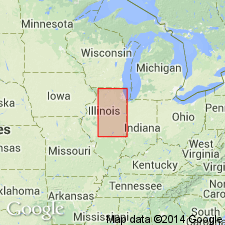
- Usage in publication:
-
- Toulon Member
- Modifications:
-
- Named
- Dominant lithology:
-
- Sand
- Gravel
- Silt
- AAPG geologic province:
-
- Illinois basin
Summary:
Named as member of Glasford Formation (new) for Toulon, Stark Co, IL (Illinois basin). Type section is exposures in borrow pit 3/4 mi west of Toulon described in the Toulon Section, NW NW SW sec 24, T13N, R5E. Consists of glacially derived sand, gravel, and silt, and is bounded above by the base of the Radnor Till Member (new) and below by the top of the Hulick Till Member (new); it can be identified as a member only when it occurs between these two till members. Is 5-10 ft thick, and probably much thicker locally. In the Jubilee College Section (Peoria Co) the member consists of calcareous, gray silt and fine sand at the top, overlying a weakly developed unnamed soil in the top of sand and gravel outwash, which in turn unconformably overlies the Hulick. Uppermost silt may be stratigraphic equivalent of Roby Silt Member of east-central IL. Compositional data given in table 5. As the minor soil in the upper part of the member is the substage boundary, most of the lower part is in the Monican Substage, and the upper silts are in the Jubileean Substage of the Illinoian Stage. Lower, outwash part of member is judged to be retreatal outwash, whereas local silts are pro-glacial deposits in front of the advancing glacier that deposited the overlying Radnor Till Member.
Source: GNU records (USGS DDS-6; Denver GNULEX).
For more information, please contact Nancy Stamm, Geologic Names Committee Secretary.
Asterisk (*) indicates published by U.S. Geological Survey authors.
"No current usage" (†) implies that a name has been abandoned or has fallen into disuse. Former usage and, if known, replacement name given in parentheses ( ).
Slash (/) indicates name conflicts with nomenclatural guidelines (CSN, 1933; ACSN, 1961, 1970; NACSN, 1983, 2005, 2021). May be explained within brackets ([ ]).

